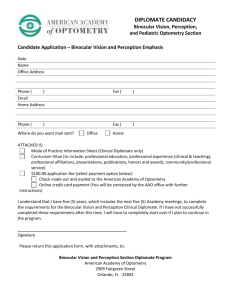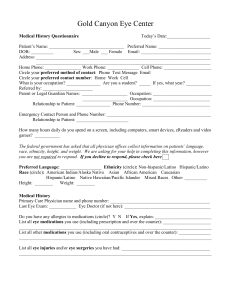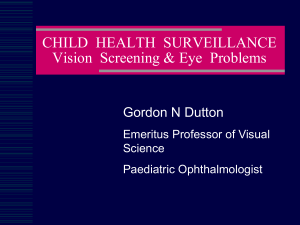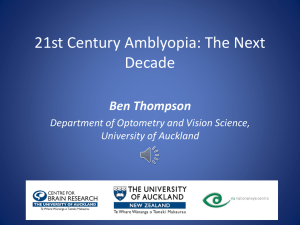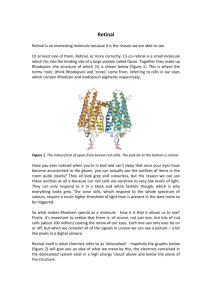OKAP REVIEW OF PEDIATRIC OPHTHALMOLOGY AND
advertisement
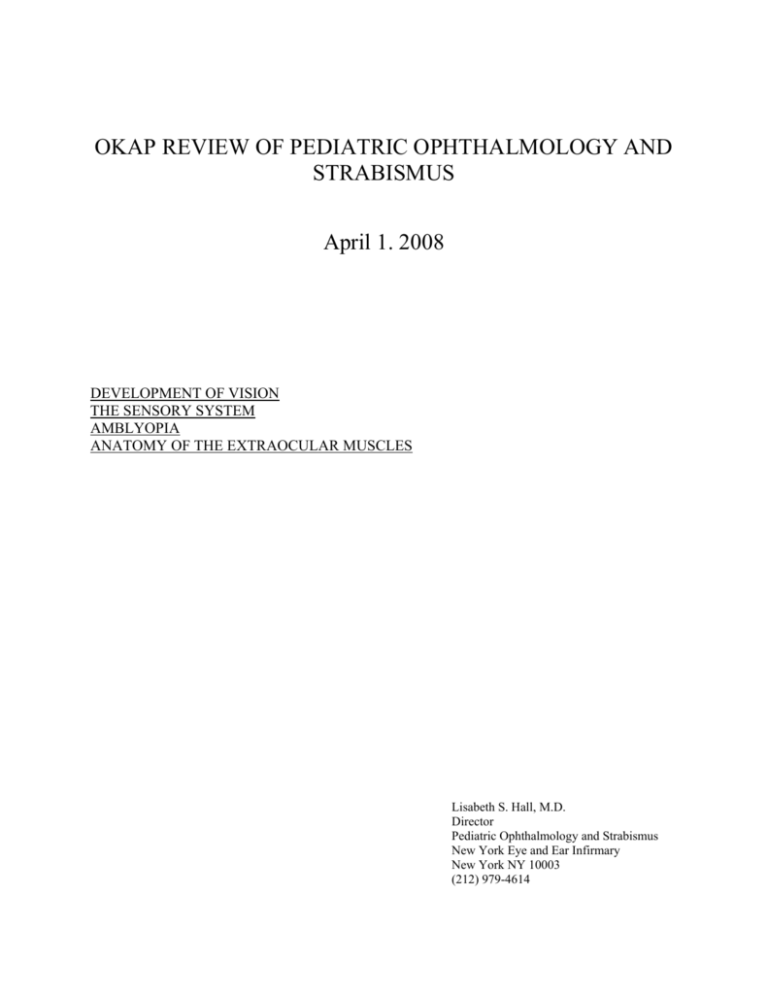
OKAP REVIEW OF PEDIATRIC OPHTHALMOLOGY AND STRABISMUS April 1. 2008 DEVELOPMENT OF VISION THE SENSORY SYSTEM AMBLYOPIA ANATOMY OF THE EXTRAOCULAR MUSCLES Lisabeth S. Hall, M.D. Director Pediatric Ophthalmology and Strabismus New York Eye and Ear Infirmary New York NY 10003 (212) 979-4614 OKAP REVIEW OF PEDIATRIC OPHTHALMOLOGY AND STRABISMUS OUTLINE 1. Sensory physiology and pathology A. Development of normal binocular vision 1) Normal retinal correspondance 2) Vieth-Muller circle 3) Empirical horopter 4) Fusion 5) Stereopsis B. Pathology of sensory function C. Abnormal Retinal Correspondance D. Diplopia 1) Physiologic diplopia 2) Confusion E. Supression F. Monofixation syndrome G. Tests of sensory anomalies 1) Worth four dot 2) Bagolini test 3) Afterimage test 4) Synoptophore 5) Amblyoscope 6) Titmus test 2. Development of the visual system A. B. C. D. 3. Anatomy of the extraocular muscles A. B. C. D. E. F. 4. Amblyopia Assessment of amblyopia Treatment of ablyopia Eccentric fixation Origin Course Insertion Action Vascular supply Orbital and facial relationships 1) Lockwoods ligament Summary OKAP REVIEW 2008 Lisabeth S. Hall, MD Director Pediatric Ophthalmology and Strabismus Pediatric Ophthalmology and Strabismus II. Sensory anomalies I. Development of the visual system OKAP REVIEW 2008 OKAP REVIEW 2008 Pediatric Ophthalmology and Strabismus Pediatric Ophthalmology and Strabismus III. Amblyopia IV. Anatomy of the EOM’s Summary, review and quiz Sensory system FORM OKAP REVIEW 2008 Pediatric Ophthalmology and Strabismus Sensory system COLOR Sensory system Sensory system + Motor system LOCATION visual space = Sensorimotor system ¾ visual sensations precipitate a chain of motor responses that move the eyes 1 Visual development Vision requires: Neurophysiology Anterior visual system Visual development Vision requires: ¾ stimulus 1) intact optical system 3) synapses with feedback 2) photo-pigment-mediated transformation 4) precise binocular mapping of the environment onto the retina, lateral geniculate body and occipital cortex of light into wave action potentials Neurophysiology Lateral Geniculate Body received by retinal photoreceptors ¾ optic nerve ¾ optic tract ¾ optic chiasm Neurophysiology Lateral Geniculate Body Neurophysiology Lateral Geniculate Body ¾ ¾ ¾ LGN or LGB thalamus ¾ ¾ ¾ Lateral Geniculate Body receives afferent fibers from the anterior visual pathway relays information to primary visual cortex mechanism unknown organized in 6 layers • 6 - outermost • 1 - innermost • uncrossed, ipsilateral - 2, 3, 5 • crossed, contralateral - 1, 4 6 Vision Neurophysiology - LGN Neurophysiology - LGN ¾ important ¾ must clinically know for BOARDS: 2 cell types: Magno-large Parvo - small P cells M CELLS WHERE WHAT parafoveal, peripheral color, two point discrimination • Magnacellular neurons • Parvocellular neurons 2 Neurophysiology Occipital lobe Development of normal binocular vision Visual space ¾ Objective ¾ also called: striate cortex Brodman’s area 17 ¾ must understand concepts of • objects in physical space outside of and independent of our visual system ¾ Subjective • visual space • conscious awareness of objects and perception by our brain • visual direction Development of normal binocular vision Visual direction Retinal correspondence ¾ normally ¾ stimulation of any retinal area results in visual sensation from a subjective visual direction fovea = visual axis = straight ahead Normal Retinal Correspondence ¾ retinal areas in the two eyes share a common subjective visual direction FL Retinal correspondence Normal Retinal Correspondence Empirical Horopter FR Normal Retinal Correspondence Empirical Horopter NRC ¾ corresponding retinal points are located on the same meridian and at the same distance from the fovea in each eye TL cyclopean eye TR FL NL NR FR TL FL NL NR FR TR 3 Empirical horopter Empirical horopter ¾ clinically defined area (3D space) where all points are seen singly ¾ fusion Vieth-Muller circle ¾ all exists points are seen singly ¾ requires ¾ model based upon assumption that eye is a perfect sphere ¾ NO Panum’s area ¾ NRC by definition stereopsis Stereopsis area around horopter where non-corresponding retinal points are stimulated without diplopia ¾ relative •based upon ability to fuse slightly disparate images •stereopsis exists •single binocular vision localization of visual objects in depth ¾ limited by distance (<20 feet) ¾ remember: monocular clues - important in interpretation of depth Sensory adaptations to strabismus Stereopsis Titmus stereo test ¾ allows stereopsis by presenting disparate images ¾ ¾ fly = 4000 sec of arc ¾ ¾ 9/9 circles = 40 sec ¾ ¾ suppression ARC diplopia confusion Random-dot stereogram ¾ no monocular clues 4 Sensory adaptations to strabismus Diplopia Confusion confusion - rare - perception of 2 images superimposed Sensory adaptations to strabismus Suppression Suppression ¾ strabismus ¾ confusing images originating from the retina ¾ central inhibition to avoid diplopia ¾ typically seen in children ¾ clinically, can give clues about etiology and age of onset of strabismus ¾ dense amblyopia ¾ ARC fusion - simultaneous perception of similar images - stimulate retinal points which normally do not correspond Sensory testing Why bother? ARC ¾ can give insight into etiology of strabismus ¾ can help with surgical plan ¾ helps to prepare the patient post-op Tests for retinal correspondence ¾ Based upon principle that images that are less “alike” are harder to fuse ¾ Tests FL FR that make images less alike (red filter) are more dissociating and therefore reveal suppression easier • i.e. diplopia NR 5 Tests for retinal correspondence Tests for Retinal Correspondence Bagolini bagolini lenses DISSOCIATION Synoptophore Red Filter Worth four-dot ¾ Striated lenses produce streaks before the R and L eye at 45 and 135 degrees Afterimage test Tests for Retinal Correspondence Synoptophore ¾ major amblyoscope synoptophore 6 Tests for Retinal Correspondence Worth four-dot ¾ Test ¾ Very for fusion dissociating WORTH FOUR DOT Patient’s view FUSION WORTH FOUR DOT Patient’s view WORTH FOUR DOT NRC - fusion eyes aligned SUPPRESSION OD ARC - fusion WORTH FOUR DOT Patient’s view SUPPRESSION OS eyes deviated 7 Tests for Retinal Correspondence Afterimage test ¾ must have central fixation each eye tested separately streak of light - horizontal image on fixing eye - vertical image on deviated eye ¾ result independent of eye position ¾ ¾ Afterimage test ¾ ¾ Right 6th nerve palsy WORTH FOUR DOT Patient’s view central cross represents direction of fovea results independent of alignment Medial rectus trauma ESOTROPIA UNCROSSED DIPLOPIA HOMONYMOUS 8 WORTH FOUR DOT Patient’s view Clinical example Bagolini lenses ARC - peripheral fusion 5 year old - BMR age 2 for esotropia EXOTROPIA ¾ “holds” in small angle CROSSED DIPLOPIA ¾ HETERONYMOUS ¾ ¾ WORTH FOUR DOT Patient’s view Bagolini lenses OS OD (10 PD) ET ACT - builds to ET 20 what may sensory testing reveal? would you operate? SENSORY TESTING Suppression OD OS ARC FUSION DOUBLE MADDOX ROD • Test for torsion Peripheral Fusion • Streaks are placed vertically and perceived horizontally Eccentric Fixation ¾Fixation 9 ANGLE KAPPA Angle between “line of sight” and the corneal/pupillary axis ¾ Positive ¾ Negative + patient looks - patient looks XT ET Amblyopia Eccentric fixation - fixation is not at the fovea ¾ MOST COMMON CAUSE OF UNILATERAL POOR VISION IN CHILDREN ¾ Prevalence 2-4% ¾ PREVENTABLE!!!! Angle kappa - fixation is at the fovea - must use ophthalmoscope Amblyopia Amblyos - (Greek) “dullness of vision” opia - from ops (Greek) vision ¾ Has come to refer to decreased vision in the setting of a “normal exam” ¾ Accepted definition: > 2 lines difference in acuity between the eyes 10 Hubel and Weisel 1970’s ¾ Nobel Prize winners ¾ identified “sensitive period” for development Amblyopia - pathogenesis ¾ Amblyopia • M and P cell mal-development • severe sensory deprivation causes reduced cell size of normal binocular vision ¾ Lateral Geniculate Body Clinical relevance - amblyopia Discovered that suturing lids of kittens resulted in atrophy of cell bodies in the LGN Amblyopia neurophysiology Lateral geniculate Amblyopia-Functional ¾ reversible ¾ ¾ ¾ anisometropic ¾ ¾ primarily defect of central vision abnormal early visual experience ¾ profound effect on neural function ¾ occipital cortex ¾ lateral geniculate ¾ receptive fields of neurons become large ¾ monocular and binocular cells affected Functional Amblyopia ¾ strabismic ¾ occlusion ¾ ¾ Child with high myopia right eye Normal left eye Secondary exotropia Must always correct refractive error and improve vision before considering strabismus surgery 11 Amblyopia - Organic Occlusion Amblyopia ¾ ¾ typically refers to ocular anomalies preventing optimal acuity ¾ abnormality may be subtle or undetectable ¾ “irreversible” ¾ may be diagnosed after failure to respond to occlusion therapy ¾ must remember that organic amblyopia may have superimposed functional amblyopia ¾ Organic cause Can result from patching Amblyopia - diagnosis Bilateral Amblyopia Pre-verbal ¾ fixation preference ¾ vertical prism test (8-10 PD) ¾ acuity • OKN, FPL, Teller, VEP Verbal ¾ Allen pictures, numbers, letters ¾ > 2 lines difference Amblyopia - Strabismus Fixation ¾ In classic “textbook” congenital esotropia infants alternate their fixation and do not become amblyopic 12 Amblyopia crowding phenomenon Amblyopia - Treatment ¾ correct refractive errors ocular problems - i.e. cataract, ptosis ¾ occlusion ¾ penalization (i.e. atropine) ¾ follow closely ¾ occlusion amblyopia - always check Va in “better” eye ¾ treat ACUITY ISOLATED > LINEAR in amblyopes Essentials of treatment ¾ ¾ ¾ ¾ ¾ ¾ Amblyopia Treatment Study Group ¾ Looking at measurement of visual acuity z Efforts to standardize ¾ Effects of treatment on child and family ¾ Comparison of ¾ ¾ ¾ ¾ Amblyopia Study Group Patching Regimens Pediatric Eye Disease Investigator Group ¾ Patient and family understanding and involvement Motivation/rewards Realistic goals Make it fun and easy Know when to stop Essentials of treatment ¾ ¾ ¾ ¾ z Drops and patching ¾ z Shorter vs. longer occlusion ¾ Archives of Ophthalmology 2003;121:603-611 189 children<7 y w/ moderate amblyopia (20/4020/80) Randomized to 2h/d vs.. 6h/d patching Both groups performed > 1 h per day of near visual activities Compliance consistent with other studies (poor) 4 m follow up Similar improvement in 2 groups Must take treatment seriously Often make contract with older kids Capitalize on their interests Visual challenging is essential Anatomy of the EOM’s ¾ Ocular alignment is determined by the extraocular muscles and their surrounding tissues ¾ PRIMARY POSITION • the eye and head are directed straight ahead • medial walls are parallel o • lateral walls are 45 from medial walls o • in primary position: SO, IO - 51 o SR, IR - 23 o MR, LR - 90 13 EOM’S Origin Inferior Oblique ¾ ¾ oval fibrous ring at the orbital apex EOMs originate at annulus EXCEPT: • inferior oblique • superior oblique • levator palpebrae superioris Insertions of the EOM’s Oblique muscles ¾ ¾ Superior Oblique ¾ ¾ orbital apex above annulus (functional origin at trochlea LPS ¾ ¾ orbital apex above annulus Cardinal positions and yolk muscles SO longest tendon, RSR LIO courses inferior to SR ¾ ¾ maxillary bone, adjacent to lacrimal fossa, posterior to orbital rim Rectus muscles insert into sclera anterior to the equator via tendons Their anatomic relationship at the insertions forms the Spiral of Tillaux Thinnest sclera (.3mm) just posterior to the insertion Cardinal positions and yolk muscles insert posterior to the equator ¾ Insertions of the EOM’s Spiral of Tillaux Origin of the EOM Annulus of Zinn IO shortest tendon, RLR LMR LSR RIO LLR RMR courses inferior to IR RIR LSO LIR RSO 14 EOM’S function ¾ function dependent upon position of the globe ¾ 1o,2o,3o action in the primary position: • medial, lateral recti - adduct, abduct • sup, inf oblique’s - elevate, depress, intort, extort, abduct • sup, inf recti - elevate, depress, intort extort, adduct Anatomy of the EOM’s Vascular supply EOM’S function ¾ CLINICAL CORRELATION ¾ CN III LPS, SR MR, IR, IO ¾ CN IV SO ¾ CN VI LR upper lower A and V patterns due to oblique overaction ET in thyroid patients with tight inferior recti Vascular supply Major: muscular branches of the MOST OFTEN ophthalmic artery Recti muscles - contain 2 anterior ciliary arteries Additional: Lacrimal artery to LR EOM - Innervation Exception - Lateral rectus contains 1 Vascular supply Recti muscles - perfuse anterior segment via anterior ciliary arteries Oblique muscles - do not contribute to anterior segment circulation Infraorbital to IO, IR Summary NRC Vascular supply ¾ Clinical Normal Retinal Correspondence Empirical horopter Relevance ¾ Horopter • Surgery on multiple recti muscles contraindicated due to risk of anterior segment ischemia • based upon NRC • points stimulate corresponding retinal elements • single vision and fusion exists ¾ Panum’s area • slightly disparate points • allows stereopsis • outside - have physiologic diplopia cyclopean eye TL FL NL NR FR TR 15 Summary Retinal correspondence ¾ Retinal Summary Anatomy ¾ Anterior segment circulation from 4 recti • all have 2 except LR has one ACA correspondence ARC Summary Amblyopia NRC Binocular ¾ major preventable cause of visual loss ¾ ¾ strabismus, anisometropia, high hyperopia, and myopia at risk All EOM orig. from annulus except IO, SO, LPS ¾ ¾ maximum FT occlusion = 1 week/year of life Recti insert anterior to equator, obliquesposterior ¾ “critical period” for development of binocular vision ¾ Inferior-extorters, Superior-intort ¾ Recti - adduct, Obliques - abduct possibly “at risk” until 10 years of age ¾ Obliques course inferior to recti ¾ GOOD LUCK!!!! QUIZ 16 LISABETH S. HALL, M.D. PEDIATRIC OPHTHALMOLOGY AND STRABISMUS QUESTIONS FOR OKAP REVIEW 2006 1. 2. Which of the following does not arise from the annulus of Zinn? 1. superior oblique. a. 1, 2, and 3. b. 1 and 3 2. levator palpebrae. c. 2 and 4 d. 4 only 3. inferior oblique. e. 1, 2, 3, and 4 4. superior rectus. T or F -- The superior oblique tendon passes between the superior rectus muscle and the globe on the way to its insertion. ANS = TRUE 3. Match each set of action from primary position listed in the left-hand column with the appropriate muscle in the righthand column. a. intorsion, depression, abduction. = 1. Inferior rectus. b. extorsion, elevation, abduction. = 2. Superior rectus. c. depression, extorsion, adduction. = 3. Superior oblique. d. elevation, intorsion, adduction. = 4. Inferior oblique. 4. T of F-- Physiologically, any point not lying on the empirical horopter will be perceived doubly by the human visual system. ANS = 5. T or F-- If simultaneous stimulation of retinal areas in two eyes leads to the perception of one image, normal retinal correspondence is said to exist. ANS = FALSE 6. T or F-- For fusion to exist, there must be simultaneous stimulation of corresponding retinal areas with normal retinal correspondence. ANS = 7. T or F-- The most important visual clues for depth perception require binocular vision. 8. T or F-- Diplopia occurs when the two foveas of a singe patient each contain a distinct retinal image. ANS = 9. T or F-- If a patient with manifest strabismus does not complain of diplopia, then suppression must be active. ANS = ANS = 10. Which of the following regarding amblyopia is/are true? 1. The incidence in general population is approximately 2 to 3 %. 2. The presence of an afferent pupillary defect clearly establishes an organic etiology for visual loss, rather than amblyopia. 3. Patient with amblyopia will frequently perform better with single-symbol acuity test targets than with line targets ("crowded stimuli") 4. A neutral density filter placed over an amblyopic eye will generally cause a greater decrement in visual acuity than the same filter placed over an eye with maculopathy. a. c. e. 1, 2, and 3 2 and 4 1, 2, 3, and 4. b. 1 and 3 d. 4 only ANS = 11. T or F-- The proper guideline for intervals between examinations for a child undergoing full-time occlusion therapy is 1 week for every month of age. ANS = 12. T or F-- Testing with Bagolini striated glasses for retinal correspondence requires preparation with cover-uncover testing and assessment of fixation behavior. ANS = 13. When tested with a Maddox rod held over the affected eye with its cylinders running horizontally, a patient with excyclotropia will perceive: a. a horizontal line. ANS = b. a vertical line. c. an oblique line running superotemporal to inferonasal. d. an oblique line running superonasal to inferotemporal. e. a curved line concave toward the nose. 14. Broad nasal bridges with abnormally large angle kappa may lead to an error in the diagnosis of strabismus with which of the following methods? 1. alternate-cover tests. a. 1, 2, and 3. b. 1 and 3. 2. Maddox rod testing. c. 2 and 4 d. 4 only 3. Cover-uncover testing. e. 1, 2, 3, and 4. 4. Hirschberg testing. ANS = D 15. T or F-- Negative angle kappa simulates esotropia ANS - 16. Compared to magnocellular cells, parvocellular neurons are more sensitive to a. Low-medium spatial frequencies b. Fine two-point discrimination c. Direction, motion, and speed d. Flicker stereopsis ANS = 17. The vertical prism or induced tropia fixation test is useful a. To measure cyclovertical deviations b. To detect amblyopia in preverbal children without strabismus c. To assess binocular cooperation d. To measure vertical fusional vergences ANS = 18. A 34-year-old man sustained closed head trauma and now complains of objects appearing tilted. The degree of tilting can be quantified by which of the following tests? a. Simultaneous prism-cover test b. Double Maddox rod test c. Careful analysis of ductions and versions together d. Lateroversion reflex test ANS = 19. Paradoxic diplopia observed after strabismus surgery in a formerly esotropic patient is most likely caused by which one of the following? a. Surgical undercorrection b. Eccentric fixation c. Surgical overcorrection d. Persistence of abnormal retinal correspondence ANS = 20. Which of the following cannot be used to test for ARC? a. Worth four-dot test b. Major amblyoscope test c. Titmus stereo test d. Cuppers monocular afterimage test ANS = 21. A patient presents with a left superior oblique muscle paresis and the following measurements. Which of the operations listed is the most appropriate? Right head tilt: LHT = 5 Left head tilt: LHT = 15 30 15 0 Right gaze a. b. c. d. Tuck LSO Tuck LSO, recess LIO Recess LIO Recess RSR and LIR 15 LHT = 10 0 0 0 0 Left gaze ANS =

